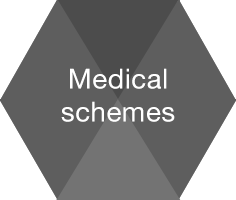Medical schemes
How to choose a medical aid
Step 1
Choose a reputable Medical Aid Scheme with an excellent track record and an acceptable solvency margin.
Step 2
Decide which type of option/plan below suits your needs best.
Deciding which option to choose is largely determined by rands and cents, i.e. affordability. However it is also important to understand the different types of options and the benefits they each offer.
Traditional Plans
These options are the ones most of us grew up with years ago (referred to as "old generation" options) and perhaps where everybody wants to be now because you simply pay your monthly contribution and the scheme takes care of the rest – no fuss no bother. Unfortunately traditional options have become very expensive.
Hospital Plans
This is a "new generation" product and like the name indicates, only covers hospital related expenses and chronic medication. Any non-hospital related expenses are all for your own account. To resolve this burden some Hospital Plans allow you to add a savings account to the option but once you have depleted the funds in your savings account, you are on your own once again.
Comprehensive Plans
This option is also from the "new generation" schemes and similar in benefits to traditional options that pays mostly everything. However, comprehensive options have a threshold for non-hospital related expenses which you must first fund out of your own pocket before the medical scheme pays the rest. To "fund" this threshold comprehensive options have a built-in savings part. Hospital related expenses do not form part of the threshold.
Network Plans
These plans offer both hospital and non-hospital related benefits but as the name indicates, these services are only available through network hospitals and network service providers. You cannot select any doctor to go and visit, nor any hospital for your procedure.
Step 3
Consult and make a decision.
Step 4
Apply for gap cover to cover hospital costs above the 100% that your scheme will not pay.
When applying for membership of a scheme, there is a fairly comprehensive application form to fill in and you are required to provide detailed medical information. For assistance in this regard and also to guide you through claims procedures, waiting periods and other pitfalls, send us an enquiry, phone us on 012 345 6480 or e-mail us at michelle@cubeadvice.com or geral@cubeadvice.com
The medical scheme industry is notorious for acronyms but they are actually crucial to understand. Take note of the following:
BHF: Board of Healthcare funders
The association to which medical schemes belong that decides the industry policy.
CMS: Council for Medical Schemes
Government appointed body to regulate the industry. They make the rules.
Capitation Agreement
Agreement between a scheme and a service provider that the service provider will receive a fixed monthly amount per beneficiary but will in return perform all the medical services required for that person(s)
MSA: Medical Schemes Act
Act 131 of 1998
BoT: Board of Trustees
Each medical scheme has an elected BoT that oversees the proper functioning of the scheme.
P.O. Principal Officer
The person who runs the administration of the scheme.
PMB: Prescribed Medical Benefits
These are 223 medical conditions that may not be excluded from a member even if still in probation period.





